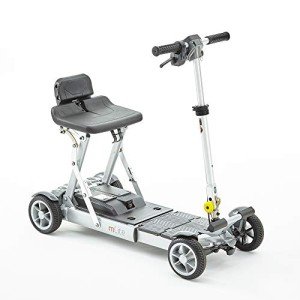Understanding Mobility Aids: Enhancing Independence and Quality of Life
As society continues to age and people significantly look for methods to keep independence, the demand for mobility aids has actually never been more pertinent. folding mobility scooters , which incorporate a variety of devices designed to assist individuals with strolling or moving, play a crucial function in promoting mobility, improving security, and enhancing total lifestyle. This blog post will explore the various kinds of mobility aids, their advantages, considerations for selection, and respond to some frequently asked concerns.
Kinds Of Mobility Aids
Different mobility aids are offered, each developed to address particular needs. The following table summarizes a few of the most common kinds of mobility aids and their functions.
| Kind Of Mobility Aid | Description | Best Suited For | Key Features |
|---|---|---|---|
| Walking canes | A portable stick offering assistance and balance. | Individuals who require very little assistance. | Light-weight, portable, adjustable height. |
| Walkers | Four-legged frames supplying stability. | Those requiring substantial assistance while walking. | Foldable, some with wheels, added security functions. |
| Rollators | Wheeled walkers with a seat for resting. | People requiring mobility with the option to rest. | Brakes, baskets for individual items, adjustable height. |
| Wheelchairs | Chairs with wheels for people with limited mobility. | Those unable to stroll or needing substantial assistance. | Handbook or powered alternatives, customizable seating. |
| Scooters | Motorized devices for bigger distances. | Individuals with restricted stamina but requiring independence. | Different sizes and styles, frequently easily transportable. |
| Crutches | Support devices put under the arms or forearms. | Individuals recuperating from lower limb injuries. | Adjustable, lightweight, needs upper body strength. |
| Stairlifts | Mechanical devices for moving in between floors. | Users facing obstacles in multi-level homes. | Personalized for different staircases, automated. |
Advantages of Mobility Aids
Mobility aids provide an array of advantages that can substantially improve the lives of individuals facing mobility difficulties. Some notable benefits include:
- Increased Independence: Mobility aids empower individuals to move easily without counting on others for assistance, consequently enhancing their self-confidence and self-confidence.
- Improved Safety: Using mobility aids can minimize the danger of falls and injuries, specifically for older adults or those with balance problems.
- Improved Quality of Life: By helping with mobility, individuals can participate in social activities, attend events, and delight in life more completely, contributing to better emotional and psychological health.
- Rehab Support: After surgical treatment or injury, mobility aids supply essential support and stability, helping in recovery and rehabilitation procedures.
- Ease of access: Many mobility aids are created to be utilized both inside and outdoors, making sure that individuals can navigate different environments with ease.
Aspects to Consider When Choosing Mobility Aids
Choosing the appropriate mobility help needs mindful factor to consider of numerous aspects, including:
| Factor | Factors to consider |
|---|---|
| User's Needs | Examine the level of mobility needed; think about whether the user requires temporary or long-lasting assistance. |
| Physical Limitations | Evaluate the user's strength, balance, and coordination to identify the very best type of aid. |
| Setting | Consider the main environments where the help will be used, such as home, outdoors, or specific terrains. |
| Weight and Portability | Guarantee that the selected gadget is workable concerning portability and storage, specifically for outdoor use. |
| Budget plan | Mobility aids can be found in a range of rates; consider insurance protection and offered funding alternatives. |
| Adjustability | Pick aids that can be changed for height and comfort to accommodate development or changing requirements. |
Regularly Asked Questions About Mobility Aids
1. How do I know if I need a mobility help?
Numerous elements can signal the need for a mobility aid, such as difficulty walking or stabilizing, fatigue while standing, or a current surgery affecting mobility. Consulting with a healthcare specialist can offer assistance customized to individual needs.
2. What types of mobility aids are covered by insurance coverage?
Protection varies between insurance providers, but many supply alternatives for resilient medical equipment, which generally consists of wheelchairs, walkers, and some types of walking sticks. Contact your insurance provider for specific coverage details.
3. Can mobility aids be used outdoors?
Yes, many modern mobility aids are designed for outdoor usage. Rollators, scooters, and some walkers are equipped with functions for stability and ease of use on various surface.
4. How do I preserve my mobility help?
Regular upkeep involves looking for any wear and tear, guaranteeing that parts such as wheels, brakes, and frames are operating properly, and cleaning up the devices as needed. Following the manufacturer's standards is crucial for security.
5. Exists a risk of becoming based on mobility aids?
While some users might end up being reliant on mobility aids, they are designed to promote independence and mobility. Gradually utilizing a mobility help can enhance self-confidence and aid maintain physical strength and coordination.
Mobility aids are invaluable tools that empower individuals to get rid of physical difficulties, promoting independence and enhancing lifestyle. By understanding the numerous kinds of mobility aids available, their benefits, and important factors for consideration, households and caretakers can make informed decisions that best fulfill the needs of their liked ones. With the right assistance, those with mobility obstacles can lead fulfilling and active lives, totally free to explore the world around them.

